People
Anthony Haden-Guest’s Intrepid Lives of the Street Artists, Part I
Street artists are never more than two steps away from being on the street.
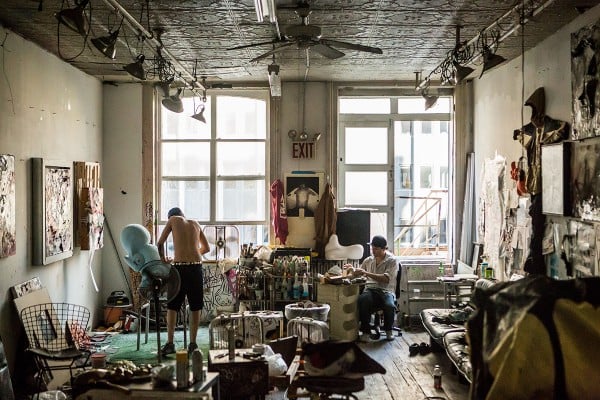
Image: Scott Furkay
Street artists are never more than two steps away from being on the street.

Anthony Haden-Guest

This is the first in a four-part series in which Anthony Haden-Guest engages Street artists in dialogue about their practice from the 1960s to today.
Before & After the Internet
Street art has been around as long as people needed to let the world know exactly how they feel. A tag found in Roman Pompeii reads: Narcissus is the biggest cocksucker. But that was part of a few thousand years of warm-up for the phenomenon today, which is just fifty years old, and which grows ever huger. And which is what we’re looking at here.
How did the phenomenon begin? And where? In the late 1960s Darryl McCray was one of a group who wrote their nicknames—his was “Cornbread”—on Philadelphia walls. Some say it began there. Others insist New Yorkers were already at it. Norman Mailer made it part of the cultural conversation with his story The Faith of Graffiti, published in Esquire in May 1974. Mailer kicked off by referencing “the famous Cay from 161 Street, there at the beginning with TAKI 183 and Junior 161.” Just five years on, Phase 2, Futura 2000, Rammellzee and Lady Pink were breaking into the gallery world and the art market too.
But mainstream artists had already been feeling the pull of the street. In 1968 Christo and Jeanne-Claude put up Iron Curtain, a wall of oil drums, in the Rue Visconti, Paris. Daniel Buren painted a stripe outside Lawrence Weiner’s studio. It was the same urge to break away from the art market structure that was propelling the Land artists. Charles Simonds, a New Yorker known for creating clay “dwelling places” for an imaginary civilization, went to Berkeley where he joined Mario Savio in the Free Speech Movement, then returned to New York, moved into a building on Chrystie Street, and settled down to make art.
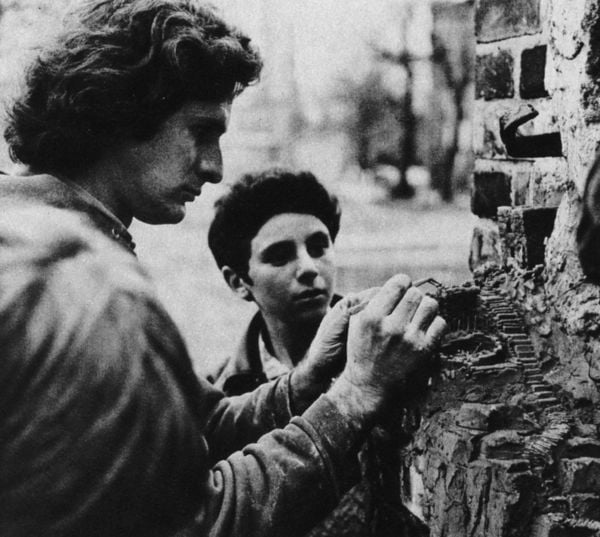
Charles Simonds constructing a dwelling in Kreuzeberg, Berlin in 1978.
Image: Courtesy of the artist.
Charles Simonds
At a certain moment I figured out what I was about. I imagined a place; an imaginary place in clay that I put down. I quickly had the idea of an imaginary people. This was 1969 and it was springtime. It was stupid to be doing it inside! I decided to go out to make homes for my little people outside.
Anthony Haden-Guest
That was when you first went onto the street?
Charles Simonds
Yes. So I went out to make dwelling places for an imaginary people. First on Greene Street, on a friend’s window ledge. And then I migrated the little people up Greene Street. Did you know 112 Greene Street? It was [the home of sculptor] Jeffrey Lew.
AHG
Yes.
Charles Simonds
So I made one on the front of their building. This was 1970, maybe. And then I used to stand there, in the gutter or on the window ledges, making my dwellings. At that time, it wasn’t SoHo yet, it was just truckers and some artists. And the truckers would check with me every morning and say, “Well, how are the little people doing?” And then the artists would come and they wouldn’t say anything. They would insult me, in fact.

Charles Simonds constructing a Dwelling on East 2nd Street, New York in 1974.
Image: Courtesy of the artist.
AHG
What artists?
Charles Simonds
They were Minimal artists—all big and strong. And tough. And hard. And I was making something soft and pink and ephemeral. Because those dwellings are always destroyed, eventually, they thought I was a little nuts. They treated me dismissively; like I was stupid or crazy—one or the other—to make Craft. Obviously I was making Craft art because I was working with clay. Who works with clay? So I moved to a neighborhood where I would get a reaction like I got from the truckers. So I chose a part of the Lower East Side, which was bordered by Houston and 14th Street, Avenue A and Avenue B. That was 1971.
AHG
You weren’t bothered that the work would almost certainly be destroyed?
Charles Simonds
That was part of it. There was an element of performance. It played a part in the life of the neighborhood.
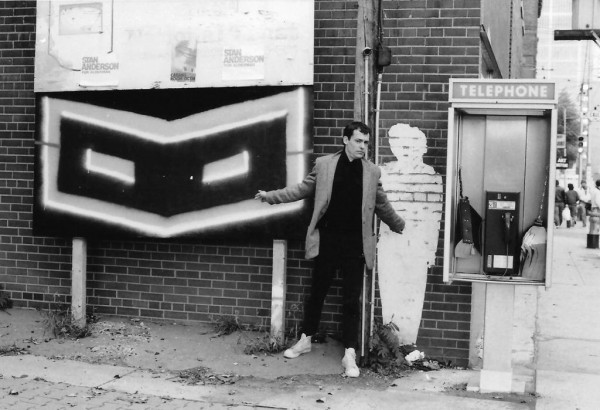
Richard Hambleton, 1981.
Image: Courtesy of Lisa Soroka and Flavio Belli Gallery
Younger artists drawn to the street included Jenny Holzer—who posted truisms on paper strips—Kenny Scharf, Keith Haring, and Jean-Michel Basquiat working as SAMO, first with Al Diaz and Shannon Dawson, then alone. In the later 70s, Richard Hambleton created Image Mass Murder, a series of installations composed of white outlines of humans around splashes of red paint. Then he put up Shadowman, explosive black shapes on walls. He has been called the “godfather of street art.”
Richard Hambleton
When I did Image Mass Murder in San Francisco, it seemed like I was a crazy guy in the street. But that was totally orchestrated and organized—an exhausting process.
AHG
You used models?
Richard Hambleton
I had friends that laid down and I traced around them. It took three days to paint San Francisco red and it made the front page of the San Francisco Examiner. So the media was part of the work. That was an achievement.
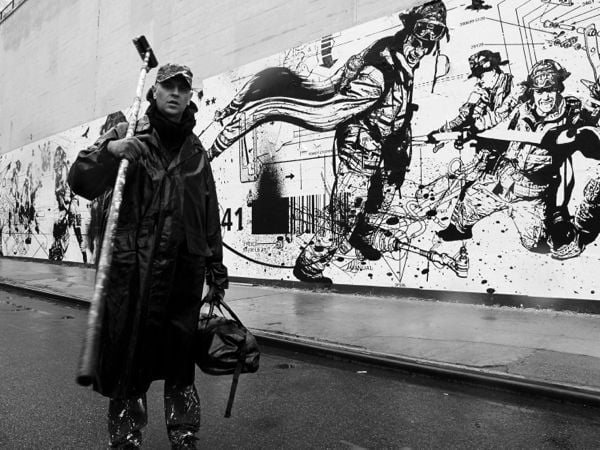
WK Interact at work.
The Village Voice ran a piece on Samo. The Examiner headlined its story on Hambleton: Nobody Died Here. This is the Work of a Sick Jokester. There was rare documentation by photographers, like Henry Flynt, Martha Cooper, and Tseng Kwongchi, but artists then were putting up stuff with little chance of it being recorded and almost no chance of physical survival.
Just how could a street artist get attention? WK Interact was 21 when he arrived in New York from the South of France. It was the mid 80s.
WK Interact
It was a tough time. I think I came six years too early. Because the Internet didn’t exist. But I had a [better chance being] early, because a lot of the locations I took nobody really wanted. The cops didn’t arrest me. They would just say, “I don’t want to see you here.” Right now, they would arrest you right away. I knew nobody. So I starved for the first three years. I had to find some jobs; in construction, painting, plumbing, carpentry. I was painting by myself. And a lot of people used to say, “That’s wack! Don’t you see? Nobody is paying you for this. It’s completely dead. You came at the wrong time. It’s done! Finished.”
AHG
Because the first generation had already happened?
WK Interact
No. There used to be a lot of galleries. Like Tony Shafrazi and the Fun Gallery. You had like five very good galleries, which just shut down. And I kept telling them. “You need to be patient, I’m not doing this just to sell something. I’m doing it because I’m passionate about this.” It was Christmastime and they gave me a permit to paint that wall on Houston Street and Broadway. So that was the first time I actually painted directly on the wall. All the ones I did before, I painted on paper, one by one, and I’d go at nighttime and paste it everywhere. And absolutely nobody was paying attention.
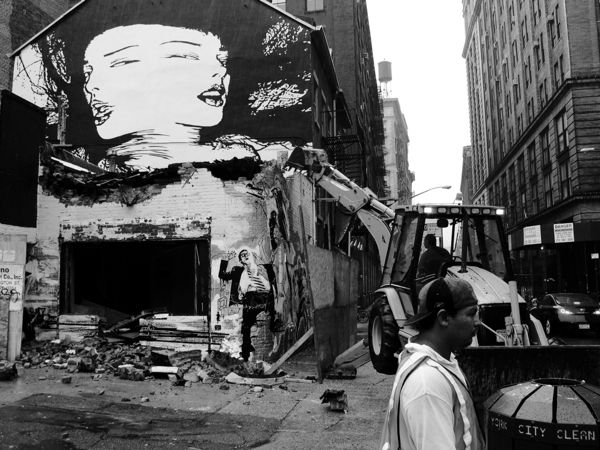
WK Interact’s mural of Shalom Harlowe in SoHo.
Image: Courtesy of the artist.
AHG
Did you have a breakthrough?
WK Interact
Yes. I was sitting, facing this wall that I had painted. It was just across from the Angelika Theater. And everyone was taking photos of the wall—kids were jumping on the wall, posing, repeating the motions. That was 1996; I had painted this wall five years before, and it received absolutely no attention—no critics, no articles, no press; absolutely zero. Because I [had] no website. It was very interesting to see when I was starving: I had lost over 17 pounds because I was eating only a one dollar box of noodles from Chinatown. And I was very depressed.
And that same day I had a message from the New York Times. They said, “We are interested to write an article about your work.” I was 25 years old. But after I had that story, my life changed. I got museum connections…a show in London…a show in Paris…. And, suddenly, I was inside.
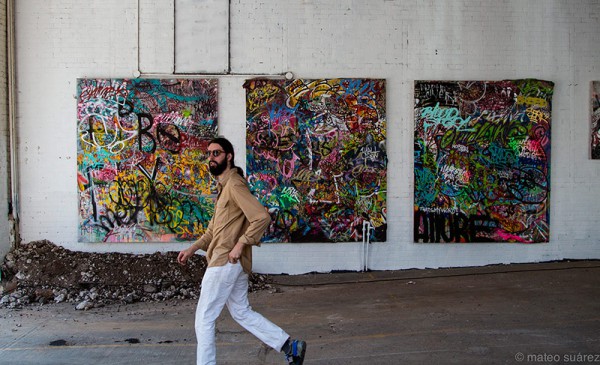
Serf in front of work at the GimmeShelter show.
Image: Courtesy of Mateo Suarez
Mint is Mikhail Sokovikov, born in Russia, raised in New York. Serf is Jason Wall, born and raised in Brooklyn. They got into skateboarding at the same high school in Southern California and have been making graffiti together in New York since 97.
AHG
Kids who leave art school, they take their portfolio around, they get a show. And, one day, they may make a living. When you set out, how did you see your future?
Serf
When we were doing graffiti? Was it a full-time job doing graffiti? I didn’t really think about or want a future. Like a normal future of money, commerce, all that shit. I didn’t want any of that. I just wanted to do graffiti. Everything was free!
AHG
Was a lot of it about getting respect from your peer group?
Mint
Yes. But I think it was a lot different before the Internet. Because, the only way you were part of the circle, if you planned to be part of a small community, it was very underground. People in New York knew people in LA just through magazines. And—
Serf
—You were either on the street, taking an active participation, taking an active role in the street conversation. Or you help out.
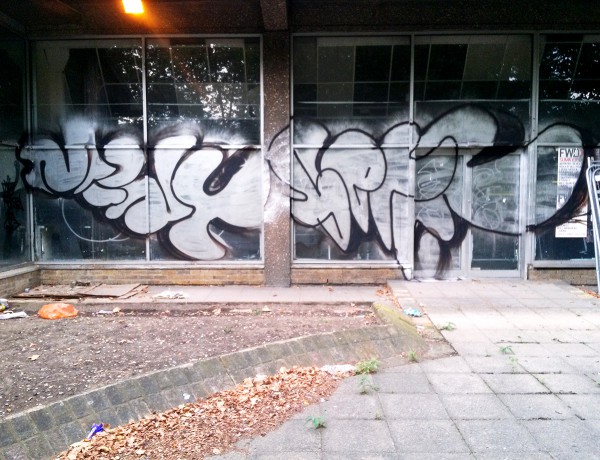
Mint and Serf.
Image: Courtesy of the artists
AHG
So how did it happen for you?
Serf
I want to say the pieces…we didn’t really communicate much with other graffiti writers for two years maybe.
Mint
—like a solid three years. We created some sort of a mystique. Like, “Who are these guys? Do you know anything about them?” And the spots that we were doing, they would deliberately be, like, virgin spots, a lot of them. They would be spots that nobody else would think about doing.
AHG
Why?
Mint
Well, it would be, like, a rooftop that would have no graffiti on it. Because graffiti attracts graffiti for a lot of artists. If you see a wall or a gate that has graffiti on it then most likely some other writer is going to go do it.
Serf
And they were also harder to get to. Not only would we paint the roof, but we would paint the ledge. So it was s little more risky. And more obvious to the street…and on top of that, we had something unique. Our style. The way we formed our letters, I guess, had a good movement and an organic flow. We would also combine into this thing called a forcefield which would look electric.
Mint
It will be Mint and Serf and then it will be this crazy flashy thug that goes around. It’s almost like advertising, a very stylized forcefield that nobody else did before.
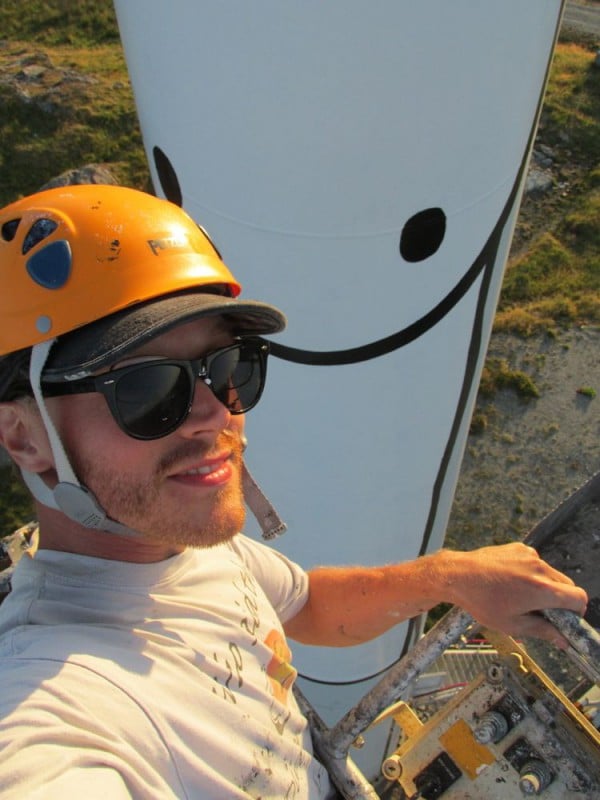
Stik at work.
Image: Courtesy of the artist.
In 2007 I visited Winzavod, a then brand-new “art district” in Moscow, which was an attempt to recapitulate forty years of New York art world development in one swoop. It included an “official” graffiti wall with a spray-painted website address. This growing global reach was transforming Street art. And the way street artists were growing their careers. When I met Stik, a Brit, he had been mostly homeless for several years, which didn’t hold him back at all. *Thursday, August 13, Stik will be signing his book at Foyle’s in London’s West End. It is published by Random House, who also published Banksy’s Wall and Piece. (Full disclosure, I wrote the introduction to the book.)
Stik
At twenty, I had moved to East London and that was really when I started doing stuff on the street. I was squatting in Hackney.
AHG
Real squats or political squats?
Stik
Well, there’s a kind of borderline. I was with people who were political squatting. And, actually, I was squatting for real. And that was kind of frustrating sometimes. Because they were into doing radical actions and I was looking for a place to get my head down.
AHG
You got some attention?
Stik
Some years ago Joe Rush of Mutoid Waste had this huge airplane fuselage that he took to the Glastonbury festival. He asked me to paint it. So I spent about a hundred pounds on spray paints. That was all I had. I hadn’t eaten properly for days. I hitchhiked up to Glastonbury and I got into the festival. I got there three days early. You have to get some sort of permission. I was hanging around in this field, really hungry. I could have died from exposure. I was completely out of my element. I painted these figures along the airplane, like they were crashing to earth. And I managed to hitchhike home. That was an ordeal. The biggest.

Stik.
Image: Courtesy of the artist.
AHG
Did you document the work?
Stik
Yes. There are lots of pictures on the Internet. That’s the thing. After a piece gets cleaned off the street, there are still photographs circulating on the Internet. It’s public property.
AHG
So the Internet did really change things?
Stik
I’m heavily dyslexic. In the 90s people were talking about this new thing, the Internet. And I found it incredibly alienating. I couldn’t operate this fucking thing that everyone was talking about; I wasn’t in on that, because of my disability. I wasn’t in the lifeboat. And so I painted on the street. There were things I wanted to share with the world. I painted them on the street. The street was my website.
AHG
There was an article in the New York Times about the decline of handwriting. Perhaps the last people doing handwriting will be doing it on the street.
Stik
Calligraphy. Yeah, hand style!
AHG
Street art works pretty well online It’s usually sophisticated in execution and it delivers its message pretty simply.
Stik
Yeah. It’s the pace with which you comprehend something that you are walking past in the street. It’s basically the same pace that you would comprehend something you are scrolling through on a web page.
AHG
The same speed with which people trot through a museum?
Stik
Not really. You see people standing around, looking at canvases in museums for twenty minutes at a time. You very rarely see that with Street art, people just contemplating. You do see it.
AHG
When we met you were living on the street. Now you have a studio. You’re in a different place.
Stik
Yes. Mainly. But you never feel far away. You can always relapse. It’s very easy. I don’t think you’re ever more than two steps away from being on the street. I still have thoughts about it. The street is really scary because you can end up there and actually no one notices. You can disappear very easily. You become like litter.
Related stories:
Moschino Designer Jeremy Scott Sued by Street Artist
17 Disruptors Who Have Completely Changed the Art World
Jeffrey Deitch’s “Coney Art Walls” Exploits Artists for Real Estate Ploy
Jerry Saltz On Why Street Art Throwdown Is Complete Crap